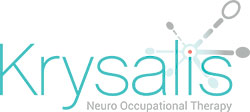Back-to-front brain discovery re-routes verbal communication rehabilitation

Findings by American neuroscientists have upended a century-old belief about where the brain’s dictionary of verbal language is located.
While in another study that impacts rehabilitation for communication challenges, gesturing has been reaping great rewards for people with aphasia.
Both studies could improve rehabilitation outcomes for people with verbal communication difficulties caused by a neuro diagnosis.
Here’s more on the findings, the five types of aphasia, and how neuro occupational therapy can help people manage communication challenges...
 Our discovery of an auditory lexicon more towards the front of the brain provides a new target area to help us understand speech comprehension deficits.
Our discovery of an auditory lexicon more towards the front of the brain provides a new target area to help us understand speech comprehension deficits. 
Prof. Maximilian Riesenhuber [1]
Since the early 1900s, it was thought that our lexicon of spoken words was sited at the back of our brain’s primary auditory cortex - a part of the temporal lobe that processes auditory information, including words.
However, new findings revealed this month by scientists at Georgetown University Medical Center in Washington, D. C., show that this verbal language catalogue is actually at the front of our primary auditory cortex: [1] New understanding of how the brain processes and stores words we hear.
It’s a new understanding that, in turn, shifts the target of rehabilitation interventions for people experiencing verbal communication challenges, such as aphasia.
With further research, it will also widen knowledge of how different types of brain injury affect speech comprehension, according to the study’s senior author, Professor Maximilian Riesenhuber of the university’s Department of Neuroscience.
"We are also trying to understand how the written and spoken word systems interact,” Prof Riesenhuber says in a report in the journal, Neurobiology of Language.
“Beyond that, we are using the same techniques to look for auditory lexica in other parts of the brain, such as those responsible for speech production."
Signs of success
In a separate study in Australia, another technique has also proven potent in making progress in communication rehabilitation outcomes.
In a systematic review of research literature, a team of university researchers sought to discover whether gesturing by people with aphasia improved their communication success [2].
And, having scoured multiple electronic databases and over 2.,000 articles, they found seven studies from which they concluded, yes, “gesture does improve the communication success of people with aphasia beyond spoken language alone”.
Here are some of the more common gestures used to aid communication after a diagnosis of aphasia:
- Flat hand, stretched out - “Stop”
- Head nod or shake – “yes” or “no”
- Copying/mimicking actions – acting out actions such as drinking or eating
- Finger pointing – to identify people, places or objects
- Pointing up or down – “higher” or “lower”, “less” or “more”
- Thumbs up or thumbs down – “yes” or “no”, “good” or “bad”, “happy” or “sad”
Types of aphasia
Over 350,000 people in the UK have aphasia, which can affect speech, language, comprehension, reading and writing.
The causes of aphasia include stroke, brain tumours and infections, traumatic brain injury, dementia, and epilepsy.
And there are five types:
- Anomic Aphasia – difficulties finding the right words to speak or write
- Expressive Aphasia – also called Broca’s aphasia, causes difficulties in speaking or writing words
- Global Aphasia - capacity for reading, writing, and speaking is severely reduced
- Primary Progressive Aphasia – abilities to read, write, talk and understand language worsen over time
- Receptive Aphasia - also called Wernicke’s aphasia, causes difficulties in understanding the meaning of words
Neuro OT and aphasia
Communication is essential for people to live independently, share their experiences, build relationships, express their needs and reach their goals in life.
So, when a neuro diagnosis causes communication challenges, it can be frustrating at best and life-limiting or isolating at worst.
A neuro occupational therapist (OT) may identify aphasia as part of a wider assessment of a person’s cognitive challenges following a neuro diagnosis.
And there are several ways they can provide support, including:
- Providing information on aphasia
- Identifying specific communication challenges
- Exploring compensatory strategies, such as communication boards and aids
- Educating caregivers
- Identifying communication-enabling activities
- Practising communication skills
- Seeking further help from a speech and language therapist
More aphasia support
Afasic - Voice for Life - for families with children and young adults with speech, language and communication needs: Home - Afasic
Aphasia Re-connect – connects people with aphasia and provides opportunities to take part in activities: aphasiareconnect.org
National Health Service (NHS) - find NHS guidance on managing aphasia here: Aphasia - Treatment - NHS
Say Aphasia - helps people with aphasia to adapt and regain their independence and confidence: Say Aphasia
Stroke Association – strong supporters of global Aphasia Awareness Month in June: Aphasia Awareness Month 2023 | Stroke Association
The Brain Charity – offers specialist advice, practical and emotional support, and social activities to people affected by aphasia: Aphasia - The Brain Charity
The British Aphasiology Society (BAS) - a national interest group supporting aphasia studies and promoting clinical aphasia services: Home - BAS
Further reading
Training conversation partners of people with aphasia…is one method that can improve access to healthcare for people with aphasia.
Aphasia and OT – helping to crack communication codes in Aphasia Awareness Month. Find out more here: https://www.krysalisconsultancy.co.uk/about-us/join-the-team






